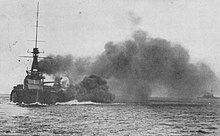HMS Monarch (1911)
|
|
|
|---|---|

|
|
| Overview | |
| Type | Battleship |
| Shipyard |
WG Armstrong, Whitworth & Co , Elswick , BauNr. 828 |
| Keel laying | April 1, 1910 |
| Launch | March 30, 1911 |
| Commissioning | April 27, 1912 |
| Whereabouts | Sunk as a target ship on January 20, 1925 |
| Technical specifications | |
| displacement |
22,000 ts |
| length |
o.a. 177.1 m (580.75 ft) |
| width |
26.8 m (88.5 ft) |
| Draft |
8.4 m (27.5 ft) |
| crew |
750 men (836 as flagship) |
| drive |
|
| speed |
21 kn |
| Range |
6730 nm at 10 kn |
| Armament |
|
| Fuel supply |
up to 3,300 tons of coal, 900 tons of oil |
|
Armor belt armor |
Type Krupp |
The HMS Monarch was a British battleship the Orion class . The four ships of the class were also referred to as super dreadnoughts in England. For the first time in British dreadnought battleships, all heavy artillery was on the midship line. In addition, a heavier caliber was introduced into the Orion class with the 13.5 inch guns.
In 1921 the HMS Monarch was decommissioned due to the Washington Fleet Agreement and sunk as a target ship by HMS Revenge in 1925 .
development
After the Imperial Navy had switched to the 30.5 cm caliber with the Helgoland class , the Royal Navy increased the caliber of the heavy artillery in the Orion class to 34.3 cm and heralded the age of the "super dreadnoughts " . In addition, for the first time on a battleship of the Royal Navy, all towers of the heavy artillery were erected in the midship line with her, with two towers being too high. This configuration was originally developed by the US Navy for South Carolina-class ships .
Mission history
The Monarch's keel was laid on April 1, 1910 at the Armstrong Warship Shipyard , and it was launched on March 30, 1911. Its acceptance tests began on November 6, 1911 and on April 27, 1912, it was assigned to the 2nd Division of the 2nd Battle Squadron ( 2nd Battle Squadron ) of the Home Fleet put into service.
In the first World War
During the First World War , the HMS Monarch and her sister ships continued to belong to the 2nd battleship squadron of the Grand Fleet stationed in Scapa Flow .
On August 8, 1914, the Monarch was unsuccessfully attacked by the German U- 15 submarine in front of the Fair Isle Canal . The cruiser HMS Birmingham discovered the surfaced submarine and opened fire. U 15 began to dive, with the cruiser ramming the submarine, which was lost with its full crew of 25 men on its first and last voyage in the war.
On December 27, 1914, Monarch rammed the HMS Conqueror and suffered damage to the bow. After a makeshift repair in Scapa Flow , she moved to Devonport for repairs . On January 20, 1915, she returned to the fleet. The Conqueror was also severely damaged in the collision and was out of order by March 1915.
In the Skagerrak Battle of May 31, 1916, the four battleships of the Orion class under Rear Admiral Arthur Leveson formed the 2nd Division of the 2nd Battle Squadron of the Grand Fleet. In the evening battle of the battle fleets, the Monarch scored no hits, but was not hit either. During the night she is said to have scored hits on the German battle cruiser Lützow , which she shot at together with the sister ship Orion . The Lützow was abandoned on the march back, so that confirmation was not possible. In total, the Monarch fired 53 rounds during the battle.
The Monarch stayed with the "Grand Fleet", whose battleships, despite several forays into the North Sea, did not enter a battle until the end of the war.
After the war
The Monarch was used up as a target ship and taken into use from June 14, 1924. Before that, all particularly valuable parts and metals had been removed in Portsmouth and the ship then towed to Hurd Depth about 50 miles south of the Isles of Scilly . On January 21, 1925, she was first attacked by bombers, which scored several hits. Then the C-class light cruisers Carysfort , Caledon , Curacoa and Calliope as well as the destroyer Vectis shot at the anchored Monarch . This was followed by the battlecruisers Hood and Repulse and the five Revenge-class battleships ( Revenge , Royal Oak , Royal Sovereign , Ramillies and Resolution ). The number of hits on the Monarch is unknown , but after nine hours it fell around 10 p.m. after a hit by the Revenge .
literature
- Geoffrey Bennett: The Skagerrak Battle. The biggest sea battle in history (= Heyne-Bücher. 5255). Wilhelm Heyne, Munich 1976, ISBN 3-453-00618-6 .
- Siegfried Breyer: Battleships and battle cruisers. 1905-1970. License issue. Pawlak, Herrsching 1970, ISBN 3-88199-474-2 .
- Peter Brook: Warships for export. Armstrong warships. 1867-1927. World Ship Society, Gravesend 1999, ISBN 0-905617-89-4 .
- Raymond A. Burt: British Battleships 1889-1904. Naval Institute Press, Annapolis MD 1988, ISBN 0-87021-061-0 .
- Randolph Pears: British Battleships. 1892-1957. The Great Days of the Fleets. Facsimile edition. G. Cave Associates, London 1979, ISBN 0-906223-14-8 .
Web links
- HMS Monarch dreadnought project
- HMS Monarch Maritimequest
- HMS Monarch ships nostalgia
- 1909 British Dreadnoughts (Orion Class.) Jane's Fighting Ships 1919
- Orion class battleships cruisers
- Orion battleships navypedia
- Orion Class Dreadnought Battleship worldwar1
Individual evidence
- ↑ according to some sources (e.g. Jane 's) Yarrow cauldron
